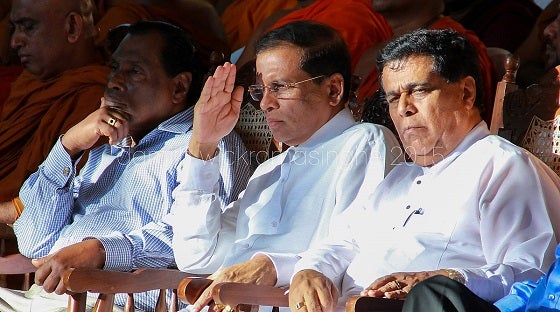Sri Lanka’s Presidential Election 2019: Structural Reforms Key to Higher Economic Growth
Amitendu Palit
28 November 2019Summary
Sri Lanka’s economic prospects are unlikely to improve till it is able to raise its rate of gross domestic product growth from the current low of 3.2 per cent. This calls for deep structural reforms. Completing reforms under the International Monetary Fund’s ongoing Extended Fund Facility might help in significantly improving long-term prospects.
The Sri Lankan economy is yet to ‘take off’ in the conventional sense of settling down in a high growth trajectory. Such a take-off was widely expected after the end of the civil war a decade ago. The years that followed did witness a rapid increase in the gross domestic product (GDP) growth. From 3.5 per cent in 2009, the GDP growth accelerated to 9.1 per cent in 2012. However, the increase was short-lived. In 2013, the GDP growth declined to 3.4 per cent. The highest growth, since then, has been a rather modest five per cent in 2015. The current GDP growth is as low as 3.2 per cent, which is lower than the rate of 3.5 per cent a decade earlier.
For the new government, reviving the rate of economic growth is a top priority. Sri Lanka’s growth is among the lowest in South Asia now. Staging a recovery from here would not be easy.
In Search of Foreign Direct Investment
The rapid rise in the GDP growth after the end of the civil conflict was due to the upsurge in economic activity driven by reconstruction. The space for such efforts in building new infrastructure has to be identified afresh. The biggest challenge will be mobilising investments to induce growth.
Since July 2018, when foreign direct investment (FDI) inflows into Sri Lanka were recorded at just over US$900 million (S$1.23 billion), the inflows have been declining. During the second quarter of the current year (April-July 2019), FDI inflows were US$230 million (S$314.1 million). The political uncertainty before the presidential elections and the Easter Sunday terrorist strikes earlier in the year affected long-term investment plans. However, unless FDI inflows recover, the economy will encounter two major challenges. There will not be sufficient resources to kick-start growth. There would also be difficulties in managing the rising volume of external debt.
Sri Lanka’s external debt is at 66 per cent of its GDP. The high debt has much to do with the liberal policy of allowing corporates, including state-owned enterprises (SOEs), to borrow directly from overseas credit markets, often backed by government guarantees. The ostensible reason behind the policy was to reduce the dependence of the SOEs on financial support from the Treasury. However, the net result has been to augment the external debt liabilities, leading to a significant rise in debt-service obligations.
There is little the government can do to reduce the current obligations. In the medium-term, however, it must increase the economy’s reliance on non-debt creating capital, that is, FDI, as the main source of external finance.
Structural Reforms
In the absence of immediate recovery in FDI and domestic private investments, the onus is on the government to stimulate investment for growth. The challenge for the government here is obvious: mobilising sufficient revenues, over and above expenditure, to channelise into investments for new projects. More than raising revenues, the harder task is to reduce expenditure.
Sri Lanka has been running a current account deficit in its balance of payments. The deficit was US$672.6 million (S$918.4 million) in the quarter ending June 2019, reflecting the excess of domestic expenditure over saving, and the need to mobilise external resources for bridging the gap.
The government does not have a magic wand to raise domestic savings and investment. Nor does it have a quick fix for cutting expenditure. Turning around the Sri Lankan economy at this juncture requires major structural policy decisions.
A Good Finish in Extended Finance Facility
Sri Lanka availed of an Extended Finance Facility (EFF) from the International Monetary Fund (IMF) in June 2016 for three years. The Facility, entailing total financial support of US$1.5 billion (S$2.05 billion), has been extended till June 2020. So far, around US$1.3 billion (S$1.76 billion) has been disbursed.
Sri Lanka’s ability to address the major structural problems facing its economy – rising public debt, shortfall in revenues, stagnant exports and ineffective governance – through the EFF might help it in securing two major goals. The first is implementing much-needed ‘hard’ decisions. These include reforms of the SOEs, including privatisation, wherever necessary; cutting inessential government expenditure; increasing flexibility in managing exchange rate; and moving to a more liberal external trade regime by cutting tariffs and incentivising exports. The second goal is the possibility of approaching the IMF again for a new round of support after a ‘good finish’ of the current EFF.
However, more IMF help might not be immediately forthcoming. However, a distinguished performance under the EFF – particularly implementation of structural reforms – would improve Sri Lanka’s credibility among the international donor and investment communities. A stronger and better image as a performer would enhance prospects of attracting long-term FDI, enabling the much-awaited ‘take off’ in GDP growth.
….
Dr Amitendu Palit is a Senior Research Fellow and Research Lead (Trade and Economic Policy) at the Institute of South Asian Studies (ISAS), an autonomous research institute at the National University of Singapore (NUS). He can be contacted at isasap@nus.edu.sg. The author bears full responsibility for the facts cited and opinions expressed in this paper.
-
 More From :
More From :
-
 Tags :
Tags :
-
 Download PDF
Download PDF



